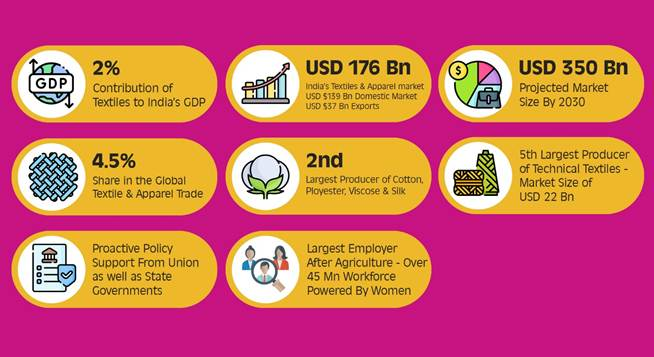Syllabus: GS3/ Economy
Context
- Bharat Tex 2025, India’s largest global textile event, took place in New Delhi, highlighting the country’s textile innovations and international trade opportunities.
About
- Bharat Tex 2025 served as a platform to accelerate the government’s “Farm to Fibre, Fabric, Fashion, and Foreign Markets” vision.
- The event featured over 5,000 exhibitors and more than 1,20,000 trade visitors, from 120+ countries including global CEOs, policymakers, and industry leaders, attended the event.
India’s Textile Industry
- India is the sixth-largest exporter of textiles globally, contributing 8.21% to the country’s total exports in 2023-24.
- The sector holds a 4.5% share in global trade, with the United States and European Union accounting for 47% of India’s textile and apparel exports.
- The industry provides direct employment to over 45 million people.

Supportive Policy Framework
- Prime Minister Mega Integrated Textile Region and Apparel (PM MITRA) Parks Scheme: 7 mega textile parks with an expected investment of USD 10 Bn are being set up with world class infrastructure, plug and play facilities and an integrated ecosystem.
- Production Linked Incentive (PLI) Scheme with approved incentives of INR 10,683 crore to promote production of Man-made fibers (MMF) Apparel, MMF Fabrics and Products of Technical Textiles.
- Samarth: The scheme is a demand-driven and placement-oriented program to build Capacity, address skill gaps in the textile value chain.
- National Handloom Development Programme (NHDP): Financial and market support for handloom weavers.
- Raw Material Support: Promotion of cotton, jute, silk, and wool to improve quality and yield.
Challenges Facing India’s Textile Industry
- High Raw Material Costs: Fluctuating cotton, jute, and synthetic fiber prices.
- Outdated Technology: Low adoption of automation and modern machinery.
- Global Competition: Strong competition from China, Vietnam and Bangladesh.
- Environmental Regulations: Compliance with sustainability norms and pollution control.
- Skilled Labor Shortage: Workforce needs upskilling to meet industry demands.
- Supply Chain Issues: Logistics inefficiencies and export-import bottlenecks.
- Limited Market Access: Trade barriers, high tariffs, and FTA limitations.
Way Ahead
- Technology Upgradation: Invest in automation and modern machinery.
- Sustainable Practices: Promote eco-friendly production and waste management.
- Skill Development: Strengthen workforce training through Samarth and other initiatives.
- Global Market Expansion: Leverage FTAs and improve export competitiveness.
- Raw Material Security: Enhance cotton, jute, silk, and wool production.
Source: PIB
Previous article
India, Qatar Elevate Ties To ‘Strategic Partnership’
Next article
NAKSHA Program